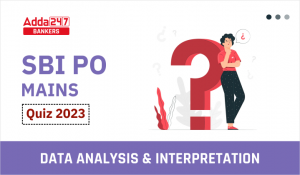(a) Borrowing account for purchase of raw materials
(b) Borrowing account for working capital against security of stocks
(c) Working capital loan account against security of stocks in possession of the borrower
(d) Borrowing account for working capital where the stocks of the borrower are in custody of the bank/lender
(e) None of the given options is true
S1. Ans.(c)
Sol. Cast credit account against hypothecation of stocks is Working capital loan account against security of stocks in possession of the borrower.
Q2. Base rate of lending was introduced by RBI to substitute the prime lending rate mechanism for fixing of interest rate on bank loans and advances. What is the reason for this decision of RBI?
(a) To exercise greater control of RBI over banks
(b) In accordance with Damodaran Committee recommendations
(c) To improve banks’ profitability
(d) For effective transmission of monetary policy changes and greater transparency
(e) None of the given options is true
S2. Ans.(d)
Sol. For effective transmission of monetary policy changes and greater transparency.
Q3. Reverse mortgage loans are meant to provide liquidity for the senior citizens. Which of the following is a proper description of this facility?
(a) Banks make either monthly payments or a lump sum payment to the senior citizen
(b) The senior citizen has to surrender the property after 15 years
(c) The legal heirs cannot repay the loan amount in case of death of the senior citizen
(d) All of the above
(e) None of the given options is true
S3. Ans.(a)
Sol. Banks make either monthly payments or a lump sum payment to the senior citizen.
Q4. Debt restructuring is often mentioned when discussing about banks’ credit portfolio. What does it suggest?
(a) The loan portfolio of banks is classified according to the amount of each loan
(b) Irregular loan accounts are assisted to regularize with modification in terms and conditions of the loan sanction
(c) Asset classification into performing and non performing accounts
(d) Substandard loan accounts are given further loans
(e) None of the given options is true
S4. Ans.(b)
Sol. Irregular loan accounts are assisted to regularize with modification in terms and conditions of the loan sanction.
Q5. Banks are not comfortable in lending to the infrastructure sector. What are the reasons for this?
(a) Banks find it difficult to fund infrastructure projects of 15 years and more
(b) Infrastructure projects require large scale funding
(c) Infrastructure financing becomes a asset liability problem for banks
(d) All of the above
(e) None of the given options is true
S5. Ans.(d)
Sol. All of the above.
Q6. Banks have different interest rate for different loan products. To which rate are there interest rates linked?
(a) Prime lending rates
(b) Base rate
(c) RBI administered rates
(d) The bank rate
(e) Repo Rate
S6. Ans.(b)
Sol. The Reserve Bank of India sets a minimum rate below which banks in India are not allowed to lend to their customers. This minimum rate is called the Base Rate in banking terms.
Q7. Which of the following is known as a secured loan of a commercial bank?
(a) Personal loans
(b) Credit card overdues
(c) Temporary overdrafts
(d) Gold loans
(e) None of the given options is true
S7. Ans.(d)
Sol. Gold loans is known as a secured loan of a commercial bank.
Q8. The net interest income for the commercial banks is an important parameter for determining the profitability. What does it denote?
(a) The difference between RBI lending rate and the average lending rate of a bank
(b) The difference in the interest rates between the fixed deposit rate and savings rate of a bank
(c) The difference between the deposit rates and the lending rates of a bank
(d) The difference in the deposit rates for the banks and the borrowing rates of RBI
(e) None of the given options is true
S8. Ans.(c)
Sol. The net interest income for the commercial banks is the difference between the deposit rates and the lending rates of a bank.
Q9. Banks are not likely to give loans against which of the following?
(a) Fixed deposits
(b) Shares of blue chip companies
(c) Gold and silver jewellery
(d) LIC policy
(e) None of the given options is true
S9. Ans.(e)
Sol.
Q10. Which of the following loans does not have and security for the bank?
(a) Educational loans
(b) Personal Loans
(c) Reverse mortgage loans
(d) Bills discounting
(e) None of the given options is true
S10. Ans.(b)
Sol. Personal Loans does not have and security for the bank.
Q11. Which is the first credit information company in India?
(a) CIBIL
(b) CARE
(c) Experian
(d) ICRA
(e) None of the given options is true
S11. Ans.(a)
Sol. CIBIL is the first credit information company in India
Q12. Reverse mortgage loans are meant for which of the following category of customers?
(a) Retired persons
(b) Retired government officials
(c) Senior citizens
(d) Individuals retired from public sector undertakings
(e) None of the given options is true
S12. Ans.(c)
Sol. A reverse mortgage is a loan for seniors age and older.
Q13. Which agency should be consulted by banks to verify whether the property to be mortgaged is free from the encumbrances?
(a) Central Electronic Registry or CERSAI
(b) Registrar of Companies
(c) Company Law Board
(d) RBI
(e) SEBI
S13. Ans.(a)
Sol. Central Registry of Securitisation Asset Reconstruction and Security Interest of India is a Government of India Company licensed under section 8 of the Companies Act, 2013 with Govt. of India having a shareholding of 51% by the Central Government and select Public Sector Banks and the National Housing Bank also being shareholders of the Company. The object of the company is to maintain and operate a Registration System for the purpose of registration of transactions of securitisation, asset reconstruction of financial assets and creation of security interest over property, as contemplated under the Securitisation and Reconstruction of Financial Assets and Enforcement of Security Interest Act, 2002 (SARFAESI Act). CERSAI is providing the platform for filing registrations of transactions of securitisation, asset reconstruction and security interest by the banks and financial institutions.
Q14. The primary aim of the Lead Bank scheme for public sector banks in India is—
(a) Big banks should try to open branches in each district
(b) Individual banks are given the responsibility to monitor the district credit plan for each adopted district
(c) The focus should be on priority sector lending
(d) All out efforts for maximum deposit mobilization in each designated district
(e) None of the given options is true
S14. Ans.(b)
Sol. The primary aim of the Lead Bank scheme for public sector banks in India is Individual banks are given the responsibility to monitor the district credit plan for each adopted district.
Q15. What is the percentage of total bank credit that banks are required to lend to the agricultural sector in India?
(a) 25%
(b) 40%
(c) 18%
(d) 10%
(e) 50%
S15. Ans.(c)
Sol. The percentage of total bank credit that banks are required to lend to the agricultural sector in India is 18 percent.






 Quantitative Aptitude Quiz For SBI PO Ma...
Quantitative Aptitude Quiz For SBI PO Ma...
 Inequalities Basic Reasoning Quiz for Al...
Inequalities Basic Reasoning Quiz for Al...





